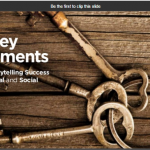When discussing the topic of social media, I like to quote John Paul Young’s 1977 disco hit Love Is In The Air. Social media is in the air. It’s everywhere we look around! The name, social media, speaks for itself. It is a growing part of today’s culture that has allowed the human race to be interactive, engaged, and well…social! Blogs, online forums, social networks (i.e. Facebook, Twitter, LinkedIn, Pinterest), multimedia channels (i.e. YouTube), etc., create an ever-growing connection between people in the digital world. Whether people are blogging, “Friending”, “Liking”, “Following”, “Pinning”, “Tweeting”, “Retweeting”, creating hashtags or creating hashtags of hashtags, there is always constant conversation and activity occurring; every second, every minute, every day!
Businesses praise the use of social media to assist with the growth of their brand and client-base. Like any average person, they work to form connections with people via social media channels. Making these connections is crucial when building customer relationships and brand loyalty. It is imperative that non-profit organizations follow the lead of these businesses and utilize social media to strengthen their presence and increase the awareness of their cause. Because seeing is believing, here are five key reasons why non-profit organizations should begin using social media to help carry forward their mission.
- For non-profits, social media creates a large opportunity to digitally engage supporters.
Organization websites and use of email blasts are a great way to share newsletters, upcoming events and other need-to-know information to supporters. With the use of mobile devices and tablets, people have easier access to checking their email if not daily, multiple times a day. But the reality of it is, people will typically not check an organizations website regularly to stay up-to-date. Creating organization pages on networks, such as Facebook and Twitter, is a great way to always keep followers in-tune with the latest and greatest. Once a page is liked by a supporter of the organization, any information that is posted to the page could show up passively in the supporter’s personal network newsfeed. This allows them to view posted updates when they access their social networks. However, organizations should not go crazy. Taking over someone’s newsfeed with too many posts may get you “Unliked” and “Unfollowed”.
- Eye-catching content creates conversation and gets people talking.
Social networks, blogs and even multimedia channels like YouTube are able to act as almost a live discussion forum, with people commenting on what has been posted. Continuous conversation comes with appealing content. It’s simply not enough for non-profits to post event information or a link to their newsletter. Creating posts in the form of a question is a good way to spark a discussion. This allows supporters to freely answer using their own voice and opinions, which helps them to connect more closely with the cause. Pictures, videos and other visuals are solid pieces of content that will also help to engage supporters. I jump at the sight of cat videos or cute puppy pictures and am quick to like and comment on them! Unfortunately, not all organizations can drive conversation using the “cuteness” factor, but any type of visual content is beneficial. You undoubtedly have people within your social communities that are passionate about your cause – visual posts that relate to that cause will engage them to interact.
- Buzzworthy content and conversation via social media helps to promote the presence of an organization.
The ALS Association fully embraced the use of social media for their cause to find a cure for Amyotrophic Lateral Sclerosis (ALS). In the summer of 2014, the association created the ALS Ice Bucket Challenge which generated a ton of buzz and went absolutely viral on multiple social media channels. People are given a video challenge to dump a large bucket ice on themselves while recording the event, followed by naming at least another three people to execute the challenge within 24 hours. The videos are then uploaded to multiple social media networks tagging the specific people that have been asked to accept the challenge. According to the ALS Association, more than 17 million people uploaded their challenge videos to Facebook in 2014; these videos were watched by 440 million people a total of 10 billion times. In the videos, supporters then state if they have donated money to the association and the amount. Supporters are not required to donate money to the cause if they are given the challenge. Just by accepting and executing the challenge, supporters are creating awareness to find the cure for ALS. I, myself accepted the challenge and donated to the cause. By executing something as simple as a video challenge, the ALS Association strongly promoted their presence and greatly increased awareness of the disease and finding a cure.
- Connecting with people through social media helps build personal relationships.
Every time an organization receives a new “Like” or “Follower”, that is one more path to making a connection and building relationships with supporters. Building personal relationships for non-profit organizations is an absolute must! Like they say, it’s not about what you know but who you know. Utilizing social media to build these crucial relationships helps to open doors for recruiting more volunteers, discovering new fundraising opportunities, and not only increasing donations from previous donors, but acquiring new donors as well. Saying “thank you” personally to supporters through social media makes them feel that they are much appreciated. Small gestures like this have a great impact.
- Social media gives an organization easy ways to track their supporters.
All of these key points come together to present the importance of social media usage for non-profit organizations. But in the end, how do you know who you’re engaging with, how many supporters you have, and how interested in your organization they are? Social media hands organizations these answers through multiple ways of tracking.
- Using an organization’s Twitter handle (i.e. @RedCross for the American Red Cross) automatically “mentions” them. The organization is able to view how many mentions they’re receiving. The more they are being mentioned means the more the organization is being talked about!
- Knowing the right and wrong times for non-profits to post to their social network pages and blogs is vital. Organizations will probably not want to post important information about an event coming up during a non-peak time when the majority of people will not be seeking to find that information (i.e. late nights). The goal is for supporters to see posted information. Tracking impressions will make sure organizations are getting this info in front of as many supporters as possible.
- Tracking the number of clicks of the event the organization just posted will help to show how many supporters are clicking on the event information. The link to the event information is more relevant to supporters if there are more clicks.
- The most simple form of tracking for organizations to look at is how many new page “Likes” they are receiving. Tracking new “Likes” by weeks, months, etc., can assist with uncovering how those “Likes” are being obtained, whether it be a current campaign or a recent event that has just taken place for the organization.
- Use the social media channel’s analytics tools. Almost all social media channels offer fairly robust analytics tools the will give you all kinds of information on your social community, who they are and how they interact with your organizations channel.
- Paid social. For very little you can experiment with different channels paid posts and ads. This will give you even more information on who is connecting with your organization and gives you the tools to pull more interested parties into your social community.
Those are just five reasons your non-profit should use social media. There are many more. What other reasons have you seen? What has worked for your organization? I’d love to hear your thoughts.
Kelsey Abbgy, account coordinator and social media fan






